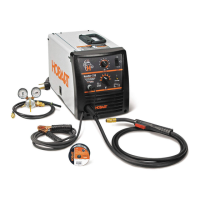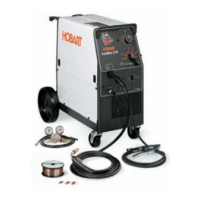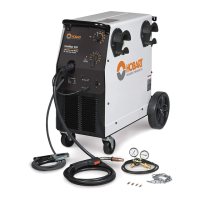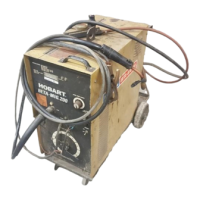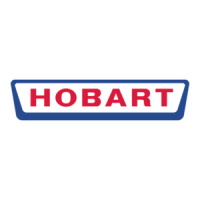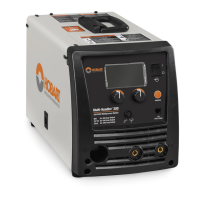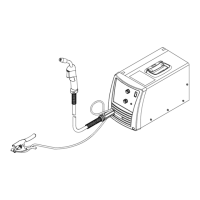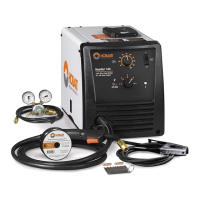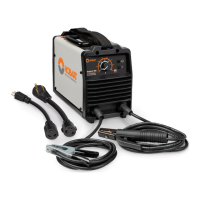Do you have a question about the Hobart 210 MVP and is the answer not in the manual?
Explains symbols used to indicate hazards and warnings in the manual.
Details potential dangers associated with arc welding processes and equipment.
Presents additional symbols related to installing, operating, and maintaining the unit.
Provides warnings regarding chemicals known to cause birth defects or cancer.
Lists key safety standards applicable to welding and cutting processes.
Explains potential interference from electromagnetic fields (EMF) with medical implants.
Defines additional safety symbols used, primarily on CE products.
Defines various miscellaneous symbols used in the manual, often related to technical specifications.
Details the location of the serial and rating label for product identification.
Provides detailed technical specifications for the unit operating at 230 VAC.
Provides detailed technical specifications for the unit operating at 115 VAC.
Explains duty cycle percentages and the causes and effects of overheating.
Illustrates volt-ampere curves showing voltage and amperage output capabilities.
Provides guidance on choosing a suitable location for the welding unit.
Details the procedure for installing the welding gun nozzle, contact tip, and adapter.
Explains the process of properly installing the work clamp for welding.
Guides the user through the correct installation of the welding gun.
Presents a table correlating welding processes with polarity and cable connections.
Describes how to change the polarity for different welding wire types.
Details the steps for connecting and installing the shielding gas supply.
Provides recommendations for electrical service requirements and circuit protection.
Offers guidance on selecting and using extension cords for optimal performance.
Explains how to connect the Multi-Voltage Plug (MVP) for different power input options.
Details the procedure for connecting the unit to the input power supply.
Provides instructions for connecting 1-phase input power for 230 VAC operation.
Provides instructions for connecting 1-phase input power for 115 VAC operation.
Guides the user on installing the wire spool and setting the hub tension.
Details the connection process for an optional spool gun.
Explains the step-by-step procedure for threading welding wire into the feeder.
Identifies and explains the function of the unit's various controls.
Provides a chart with recommended settings for different welding parameters.
Outlines regular maintenance tasks to keep the equipment in good condition.
Explains the overload protection system and how to reset it.
Describes the drive motor protection circuit and its function.
Details the procedure for changing the drive rolls and wire inlet guide.
Explains how to replace gun components and clean the gun casing.
Provides instructions for replacing the gun switch and/or head tube.
A table listing common problems and their recommended solutions.
Presents the overall electrical schematic of the welding unit.
Illustrates typical connection setups for GMAW (MIG) welding processes.
Provides general guidelines for GMAW (MIG) process control settings.
Details proper techniques for holding and positioning the welding gun.
Explains factors influencing weld bead shape, such as gun angle and travel speed.
Describes different gun movement techniques for various weld joint types.
Illustrates and describes common characteristics of poor weld beads.
Illustrates and describes common characteristics of good weld beads.
Addresses causes and corrective actions for excessive spatter during welding.
Addresses causes and corrective actions for porosity in weld metal.
Addresses causes and corrective actions for excessive weld penetration.
Addresses causes and corrective actions for lack of weld penetration.
Addresses causes and corrective actions for incomplete fusion in welds.
Addresses causes and corrective actions for burn-through during welding.
Addresses causes and corrective actions for waviness in the weld bead.
Addresses causes and corrective actions for distortion during welding.
A chart detailing common GMAW (MIG) shielding gases and their applications.
Troubleshooting guide specifically for semiautomatic welding equipment issues.
Lists available accessories for the welding equipment.
Lists common consumables such as contact tips, nozzles, and drive rolls.
Explains symbols used to indicate hazards and warnings in the manual.
Details potential dangers associated with arc welding processes and equipment.
Presents additional symbols related to installing, operating, and maintaining the unit.
Provides warnings regarding chemicals known to cause birth defects or cancer.
Lists key safety standards applicable to welding and cutting processes.
Explains potential interference from electromagnetic fields (EMF) with medical implants.
Defines additional safety symbols used, primarily on CE products.
Defines various miscellaneous symbols used in the manual, often related to technical specifications.
Details the location of the serial and rating label for product identification.
Provides detailed technical specifications for the unit operating at 230 VAC.
Provides detailed technical specifications for the unit operating at 115 VAC.
Explains duty cycle percentages and the causes and effects of overheating.
Illustrates volt-ampere curves showing voltage and amperage output capabilities.
Provides guidance on choosing a suitable location for the welding unit.
Details the procedure for installing the welding gun nozzle, contact tip, and adapter.
Explains the process of properly installing the work clamp for welding.
Guides the user through the correct installation of the welding gun.
Presents a table correlating welding processes with polarity and cable connections.
Describes how to change the polarity for different welding wire types.
Details the steps for connecting and installing the shielding gas supply.
Provides recommendations for electrical service requirements and circuit protection.
Offers guidance on selecting and using extension cords for optimal performance.
Explains how to connect the Multi-Voltage Plug (MVP) for different power input options.
Details the procedure for connecting the unit to the input power supply.
Provides instructions for connecting 1-phase input power for 230 VAC operation.
Provides instructions for connecting 1-phase input power for 115 VAC operation.
Guides the user on installing the wire spool and setting the hub tension.
Details the connection process for an optional spool gun.
Explains the step-by-step procedure for threading welding wire into the feeder.
Identifies and explains the function of the unit's various controls.
Provides a chart with recommended settings for different welding parameters.
Outlines regular maintenance tasks to keep the equipment in good condition.
Explains the overload protection system and how to reset it.
Describes the drive motor protection circuit and its function.
Details the procedure for changing the drive rolls and wire inlet guide.
Explains how to replace gun components and clean the gun casing.
Provides instructions for replacing the gun switch and/or head tube.
A table listing common problems and their recommended solutions.
Presents the overall electrical schematic of the welding unit.
Illustrates typical connection setups for GMAW (MIG) welding processes.
Provides general guidelines for GMAW (MIG) process control settings.
Details proper techniques for holding and positioning the welding gun.
Explains factors influencing weld bead shape, such as gun angle and travel speed.
Describes different gun movement techniques for various weld joint types.
Illustrates and describes common characteristics of poor weld beads.
Illustrates and describes common characteristics of good weld beads.
Addresses causes and corrective actions for excessive spatter during welding.
Addresses causes and corrective actions for porosity in weld metal.
Addresses causes and corrective actions for excessive weld penetration.
Addresses causes and corrective actions for lack of weld penetration.
Addresses causes and corrective actions for incomplete fusion in welds.
Addresses causes and corrective actions for burn-through during welding.
Addresses causes and corrective actions for waviness in the weld bead.
Addresses causes and corrective actions for distortion during welding.
A chart detailing common GMAW (MIG) shielding gases and their applications.
Troubleshooting guide specifically for semiautomatic welding equipment issues.
Lists available accessories for the welding equipment.
Lists common consumables such as contact tips, nozzles, and drive rolls.
| Weldable Materials | Steel, Stainless Steel, Aluminum |
|---|---|
| Processes | MIG (GMAW), Flux-Cored (FCAW) |
| Input Frequency | 60 Hz |
| Amperage Output | 140A |
| Spool Size Capacity | 4 in / 8 in |
| Welding Amperage Range | 25-140A (120V), 25-210A (240V) |
| Input Phase | Single Phase |
| Wire Size | 0.023-0.035 in (0.6-0.9 mm) |
| Input Voltage | 115V / 230V |
